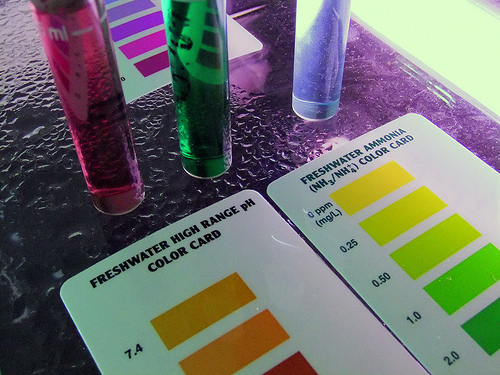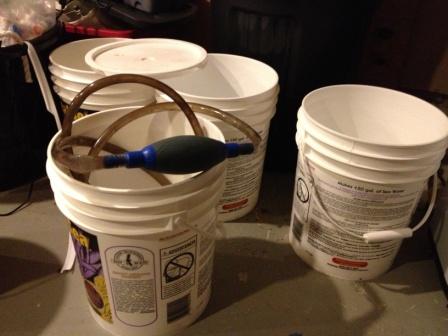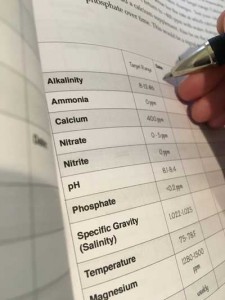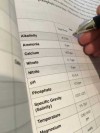Consistency is one of the most important concepts when it comes to having a successful saltwater aquarium. The animals we keep in our tanks tend to do best when the water quality is high and the conditions are stable. That’s why it is so important to create a routine and stick with it.
Consistency means creating good habits.
- Testing your saltwater aquarium water
- Monitoring the health of your livestock
- Performing routine maintenance routinely
- Planning out purchases
- Recording your results and tracking your progress
Testing your saltwater aquarium water

There are a few essential saltwater aquarium water parameters that you should be checking on a routine basis. How often is routine? Well, that all depends on how stable you know your water parameters are, in the first place. If you’re just starting out, I recommend you monitor the core water parameters daily. The core parameters are your temperature, pH, salinity, ammonia, nitrites, nitrates, and hardness daily. Your temperature, pH, and salinity should always be stable. The salinity will drift higher very slowly, over time, as freshwater evaporates from your tank, but ammonia and nitrites should remain undetected (~0 on your test kit) unless your tank is cycling. You can read more about cycling a saltwater aquarium here. Nitrate levels will go up, over time, and will eventually cause problems.
Monitoring the health of your livestock
While you have your new livestock in quarantine, you will want to watch them and monitor their health daily, looking carefully for any signs of parasites, malnutrition, or disease. The whole point of quarantine is that you want to detect and treat any problems in isolation in the QT tank to prevent those problems from making their way into the display tank. After you have added your livestock to the display tank, you want to continue monitoring them:
- Because that is why you love this hobby in the first place
- Because you want to look for any signs of stress or disease
If you notice any signs or symptoms, it is important to document it, so that you can track any problems that might result from it and also determine if certain problems keep coming up, over time.
Performing routine maintenance routinely
 Performing routine maintenance routinely is another important habit that will help improve the consistency of your saltwater aquarium. As I mentioned in the testing your saltwater aquarium water section, nitrates will accumulate in your water over time and the nitrates level will go up. When nitrates levels get too high, they fuel the growth of problem algae and can also affect the health of some invertebrates. At extremely high levels, your fish will be stressed, too. The best way to remove nitrates from your aquarium water is to perform partial water changes at regular intervals. Weekly water changes of 10-20% of the water volume is generally a pretty broadly accepted and recommended level if you can stick with it. Consistency is the key. Try to pick a day of the week and time you can commit to in order to reinforce the good habit.
Performing routine maintenance routinely is another important habit that will help improve the consistency of your saltwater aquarium. As I mentioned in the testing your saltwater aquarium water section, nitrates will accumulate in your water over time and the nitrates level will go up. When nitrates levels get too high, they fuel the growth of problem algae and can also affect the health of some invertebrates. At extremely high levels, your fish will be stressed, too. The best way to remove nitrates from your aquarium water is to perform partial water changes at regular intervals. Weekly water changes of 10-20% of the water volume is generally a pretty broadly accepted and recommended level if you can stick with it. Consistency is the key. Try to pick a day of the week and time you can commit to in order to reinforce the good habit.
Partial water changes aren’t the only routine maintenance, though. You will want to set up a maintenance schedule to clean equipment:
- aquarium glass or acrylic walls
- pumps
- powerheads
- overflow intakes
- protein skimmer collector cups
- replace light bulbs (if using power compact, metal halide or fluorescent lights)
Planning out purchases
One of the biggest mistakes people make in this hobby (myself included) is buying things spontaneously, without doing the proper research. The good news is that many of us can do a quick search on our phones while we are in the local fish store, but all too often, that search lacks the depth we need to be sure that the fish or coral that captured our attention in the store is a good fit for our tanks. By the time you bring them home and put them into your tank–it’s already too late.
Recording your results and tracking your progress
 The most important thing you can do to build good habits is to record your results and track your progress. It may seem like a small psychological step, but it is an important one. Recording the results every time you test helps reinforce the habit. It also helps you identify problems before they become a problem. I have noticed with my own tank that it’s a lot easier to skip a chore, a week, or even longer. But when you’re holding yourself accountable by recording every result in your journal, I think you’ll find it much harder to break the streak and it’s easier to see the importance of not skipping a week when you have to write that nitrate level down. That makes it much harder to ignore it.
The most important thing you can do to build good habits is to record your results and track your progress. It may seem like a small psychological step, but it is an important one. Recording the results every time you test helps reinforce the habit. It also helps you identify problems before they become a problem. I have noticed with my own tank that it’s a lot easier to skip a chore, a week, or even longer. But when you’re holding yourself accountable by recording every result in your journal, I think you’ll find it much harder to break the streak and it’s easier to see the importance of not skipping a week when you have to write that nitrate level down. That makes it much harder to ignore it.
Where should you record your results?
If you want to keep it low tech, you can simply write down your results in a copybook or record your results in spreadsheet software like Microsoft Excel or Google Sheets.
If you want something more stylish than a copybook, check out the Reef Journal. It’s a comprehensive tool to help you plan out your saltwater aquarium, track your test results, and record your progress as your tank develops.
Written by Albert B. Ulrich III–author of The Reef Aquarium Series of books: The New Saltwater Aquarium Guide, How to Frag Corals, 107 Tips for the Marine Reef Aquarium.


Leave a Reply